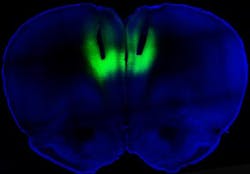Optogenetic brain stimulation could lead to treatment for cocaine addiction
By stimulating one part of the brain with laser light—using a technique known as optogenetics—researchers at the National Institutes of Health (NIH; Bethesda, MD) and the Ernest Gallo Clinic and Research Center at the University of California San Francisco (UCSF) have shown that they can switch off behavior that results from cocaine addiction in rats. The technique also enabled the researchers to turn non-addicted rats into compulsive cocaine seekers.
Related: Optogenetics proves cocaine's effect on brain, reverses change
Related: Teen optogenetics project takes top NIDA Addiction Science Award
"When we turn on a laser light in the prelimbic region of the prefrontal cortex, the compulsive cocaine seeking is gone," says Antonello Bonci, MD, scientific director of the intramural research program at the NIH's National Institute on Drug Abuse (NIDA), where the work was done. Bonci is also an adjunct professor of neurology at UCSF and an adjunct professor at Johns Hopkins University (Baltimore, MD).
The research team's work demonstrated the central role that the prefrontal cortex plays in compulsive cocaine addiction. It also suggests a new therapy that could be tested immediately in humans, says Billy Chen of NIDA, who led the study.
Any new human therapy would not be based on using lasers, but would most likely rely on electromagnetic stimulation outside the scalp, in particular a technique called transcranial magnetic stimulation (TMS). Clinical trials are now being designed to test whether this approach works, Chen adds.
What makes the new work so promising, says Bonci, is that Chen and his colleagues were working with an animal model that mimics this sort of compulsive cocaine addiction. The animals, like human addicts, are more likely to make bad decisions and take cocaine, even when they are conditioned to expect self-harm associated with it.
Electrophysiological studies involving these rats have shown that they have extremely low activity in the prefrontal cortex—a brain region fundamental for impulse control, decision making, and behavioral flexibility. Similar studies that imaged the brains of humans have shown the same pattern of low activity in this region in people who are compulsively addicted to cocaine.
To test whether altering the activity in this brain region could impact addiction, Chen and his colleagues employed optogenetics to shut the activity on and off using a laser. First, they took light-sensitive proteins called rhodopsins and used genetic engineering to insert them into neurons in the rat's prefrontal cortex. Activating this region with a laser tuned to the rhodopsins turned the nerve cells on and off. Turning on these cells wiped out the compulsive behavior, while switching them off turned the non-addicted ones into addicted, the researchers found.
What's exciting, said Bonci, is that there is a way to induce a similar activation of the prelimbic cortex in people through a technique called transcranial magnetic stimulation (TMS), which applies an external electromagnetic field to the brain and has been used as a treatment for symptoms of depression.
Bonci and his colleagues plan to begin clinical trials at NIH in which they will use this technique a few sessions a week to stimulate the prefrontal cortex in people who are addicted to cocaine and see if they can restore activity to that part of the brain and help them avoid taking the drug.
Full details of the research team's work appear in Nature; for more information, please visit www.nature.com/nature/journal/vaop/ncurrent/fig_tab/nature12024_ft.html.
